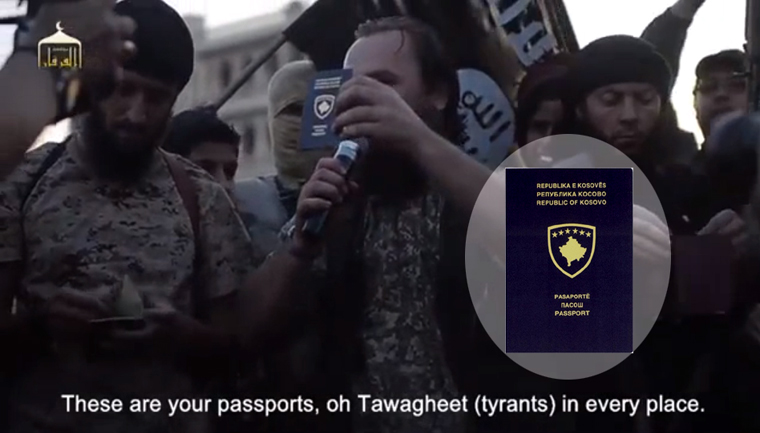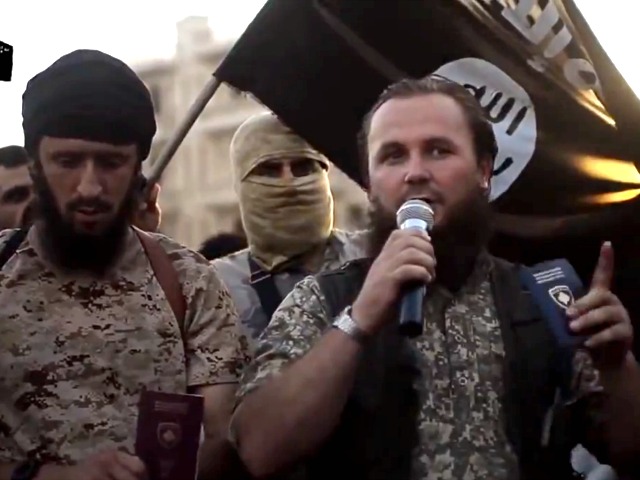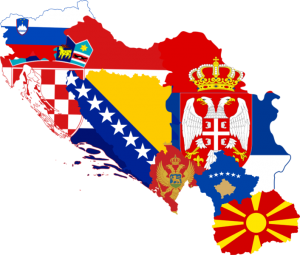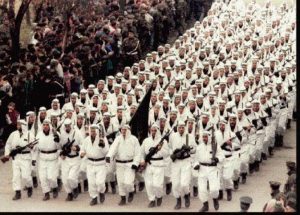
Views: 1314
Should anyone have had any doubts, the barbaric murder of US photojournalist James Foley fully exposes the true nature of the Islamist terrorists menacing the Middle East. Unfortunately, the savagery exhibited in what happened to James Foley was not unique—beheadings and suicide bombings have become standard tactics in the Islamist terrorists’ way of war. Just weeks before Foley’s murder Kosovo jihadi Lavdrim Muhaxheri posted similar photos of himself “in action” in Iraq. Such Islamist-terrorist ritual beheadings were seen during the Bosnian jihad as well, when extremists would produce “promotional videos” of their efforts showing the decapitation of Serb prisoners, or, in another case, when Bosnian jihad veteran Omar Saeed Sheik was involved in the murder/ beheading of Wall Street Journal reporter Daniel Pearl.

The expansion of militant Islamism from places such as Afghanistan, Egypt and Saudi Arabia to parts of the world such as the Balkans is no accident; it is part of a complex phenomenon involving several distinct elements, not the least of which is an organized, well-funded effort by hardline Islamist states to export their extremist ideologies to other parts of the world. With respect to the Balkans, for instance, by one estimate the Saudis alone spent $1 billion (US) on “Islamic activities” in Bosnia between 1992-1998.
The second important element in the spread of militant Islamism is the education of increasing numbers of local Islamic clerics in the Middle-Eastern universities and madrasas where the most extreme interpretations of Islam are promoted. All of the leaders of the Balkan militant Islamist movement, for instance, including individuals such as Nedžad Balkan, Bilal Bosnić, Nezim Halilović-Muderis, Nusret Imamović, or the Kosovo clerics (and Al-Azhar alumni) Zekerija Qazimi and Lulzima Qabashi, recently arrested for recruiting young men for the Syrian and Iraqi jihads, were educated in the Middle-East, where they were exposed to the ideology of militant Islamism and formed connections and ties with other members of the global jihad movement.
The third (and probably the most crucial) element in the emergence of a militant Islamist movement is the existence of an indigenous extremist group that endorses and adopts its ideological precepts. As we have seen in the case of the Balkans, when these elements converge, the outcome is an intelligence and security debacle, as is clear from reviewing the numerous Bosnian connections to the World Trade Center attacks in 1993 and 2001.
In April 2008, Richard Holbrooke claimed that “If it had not been for the Dayton Peace Accords, 9/11 would probably have been planned in Bosnia, not in Afghanistan.” The numerous Bosnian connections to both World Trade Center attacks suggest that the situation was probably even more serious than Holbrooke realized. Although no evidence has yet emerged that Izetbegović or his associates had prior knowledge of or approved of the two World Trade Center attacks, what is clear is that they directly associated and collaborated with the individuals and groups that did. As former Al Qaeda operative Ali Hamad testified, during the Izetbegović, period Al Qaeda operatives came to Bosnia with “state protection,” and both the U.S. and Saudi governments accused the Izetbegović, a regime of providing travel documents to known terrorists. In just one telling example of the extent to which international terrorists could obtain new identities in Bosnia, in September 1997 Italian police uncovered a plot to assassinate the late Pope John Paul II during a pastoral visit to Bologna—and all of the fourteen men arrested were travelling on Bosnian passports. Indeed, Izetbegović, could probably boast hosting more international terrorists per square kilometre of the territory he controlled than could Mullah Omar and the Taliban in Afghanistan. As Richard Clarke, former National Coordinator for Security, Infrastructure Protection, and National Security noted,
“Many of the names we first encountered in Bosnia showed up later in other roles, working for Al Qaeda. Although Western intelligence agencies never labelled [the mujahedin activities] in Bosnia an al Qaeda jihad, it is now clear that is exactly what it was.”
This, of course, follows a well-established, predictable pattern of what ensues when militant Islamist movements take control of territory and institutions, and ideological affinities impel them toward alliances with the most extreme elements among the militant Islamist spectrum. Whether observing Afghanistan under the Taliban, Iran under the Ayatollah Khomeini and Mahmud Ahmadinejad, Lebanon under Hezbollah, the Gaza Strip under Hamas, Sudan under Hasan al-Turabi and his National Islamic Front, or Bosnia under the Izetbegović, regime, such movements consistently provide the permissive environments and safe havens Islamist terrorists need to set up the organizations and infrastructure needed to plan operations and train and recruit new adherents.
Bernard Henry Levy was a close associate and propagandist of Izetbegovic’s fanatic regime; a few years later, the same BHL supported other Islamists around the globe – in Syria, for ex.

How and why Bosnia became what is probably Al Qaeda’s main safe haven and operational base in Europe is a complicated story, of which the war in Bosnia in the 1990s certainly plays a large part. Outmanned and outgunned, it was predictable that the Izetbegović, regime would accept help from where it could get it.
Yet to reduce Al Qaeda’s presence in the region to the exigencies of war ignores the many other factors involved in this phenomenon. Here a comparison of the different trajectories Bosnia and Kosovo have taken with respect to Islamist militancy is instructive, for it reveals the vital importance local leadership choices play in determining whether or not Al Qaeda establishes a prominent presence in a specific country. Both Bosnia and Kosovo (together with Albania) can be said to have the most secular and pro-Western Muslim populations in the world. Yet although Kosovo is fighting its own battle against Islamist extremism, Kosovo’s dominant elites never showed any express interest in militant political Islamism.
Bosnia provides a substantially different example. Support and enthusiasm for extreme Islamist movements is a demonstrable constant in Alija Izetbegović,’s political career. From the 1940s, when Izetbegović’s “Young Muslim” movement swore an oath asking Allah to grant them perseverance on their “path of jihad,” their “uncompromising struggle against everything non-Islamic” and their self-confessed goal of creating a “great Islamic state,” to the 1970s when Izetbegović, would claim that “There is no peace or coexistence between Islamic faith and non-Islamic social and political institutions,” to the early 1980s when Izetbegović and his colleagues were building relationships with the Ayatollah Khomeini’s Islamic Republic, what remained consistent in Izetbegović’s political outlook was a preference for more extreme Islamic states such as Pakistan and Iran and a pronounced distaste for moderate, secularly-oriented Muslim states such as Kemalist Turkey. As Robert Baer, a CIA agent stationed in Bosnia during the war noted, “In Sarajevo, the Bosnian Muslim government is a client of the Iranians . . . If it’s a choice between the CIA and the Iranians, they’ll take the Iranians any day.” Dangerous evidence of this was seen when Izetbegović’s intelligence service betrayed the incoming CIA station chief to the Iranians in Bosnia, who quickly beginning planning his assassination.
Apart from leadership choices, another factor playing a large role in how Bosnia became such an important element in Al Qaeda’s global strategy was financial. The hundreds of millions of dollars states such as Saudi Arabia, Iran and other hardline Islamic countries put into Bosnia bought considerable loyalty, or at the very least a willingness on the part of Izetbegović’s officials to ignore the activities of the numerous “charities” and “humanitarian organizations” operating as Al Qaeda front operations in Bosnia. In 1996, the CIA determined that Izetbegović, himself was “literally on the [Iranian] payroll,” receiving on just one occasion $500,000 (US) in cash from Iranian agents.
The first World Trade Center bombing in February 1993 was financed in part by monies provided by the Third World Relief Agency (TWRA), a Vienna-based “Islamic charity” founded by a long-time Izetbegović, associate, the Sudanese national Elfatih Hassanein. Former National Security Agency analyst John Schindler has called TWRA “Bosnia’s unique gift to radical Islam and Al Qa’ida . . . the Bosnian ‘model’ of how to use NGOs and aid money to pay for jihad and terrorism.” According to Thomas Joscelyn,
“TWRA was run by senior Bosnian government officials and sponsored the relocation of hundreds, if not thousands, of jihadists to Bosnia to fight in the 1990s. While carrying out some legitimate humanitarian functions as a cover, TWRA was really a front for global terrorist operations.”
A number of Alija Izetbegović’s closest associates were on the board of TWRA. At a meeting in Vienna on 14 September 1992 attended by Izetbegović, Ejup Ganić, Haris Siljadžić and Hassanein, Izetbegović intimates Irfan Ljevaković, Husein Živalj and Derviš Djudjević were elected to the board of TWRA. (Živalj, and Djudjević had gone to prison with Izetbegović that Hassanein, Cerić, Hasan Čengić (widely considered to be the leading Iranian agent in Bosnia, and Bakir Izetbegović (currently a member of Bosnia’s joint state presidency) also controlled the Vienna TWRA account.
Clement Rodney el-Hampton, an American who had trained in terrorist camps in Afghanistan, admitted in federal court that he had obtained TWRA funds to operate military-style training camps in New York, Connecticut, and Pennsylvania for individuals who would go on to be involved in the 1993 World Trade Center attack. In addition to obtaining TWRA funds from Vienna, Hampton-el is also reported to have gone to Bosnia circa 1992-93. Another TWRA employee, John Fawzan, was discovered to have been the suicide bomber involved in the October 1995 attack on the police headquarters in Rijeka, Croatia. In December 1995, Bosnian Croat forces near Zepce in central Bosnia killed an individual wanted in connection with the first World Trade Center bombing.
Another individual involved with TWRA was Omar Abdel-Rahman, a.k.a. “the blind sheikh,” convicted in U.S. federal court for seditious conspiracy in the Landmarks Bombing Plot in 1993, which had targeted the United Nations Building, the Lincoln and Holland tunnels, the George Washington Bridge, and FBI headquarters in Manhattan.
The Bosnian connections to the greatest mass murder in American history are just as direct. Khalid Sheikh Muhammed, the mastermind of the 9/11 attacks, fought in the Bosnian jihad and was given Bosnian citizenship. Two other 9/11 bombers, Khalid al Mindhar and Nawaf al Hamzi, also fought in Izetbegović’s army. The British journalist Eve-Anne Prentice of The Guardian and German journalist Renate Flottau of Der Spiegel reported meeting Osama Bin Laden in Izetbegović’s office during the war, and Bin Laden was even given a Bosnian passport by Izetbegović’s foreign ministry. When asked to respond to allegations that he had met bin-Laden and Ayman al-Zawahiri, Izetbegović’ evasively replied: “During and after the war I met with thousands of people coming from the Islamic world but I can remember the faces and names of only a few.”[25] The Bosnian politician Sejfudin Tokić has claimed that Council of Europe officials had told him of the existence of a photograph showing Izetbegović with bin-Laden.
The core group behind the 9/11 attacks was Al Qaeda’s so-called “Hamburg cell,” led by Bosnian jihad veteran Mohammed Haydar Zammar, reportedly the man who recruited Mohammed Atta, the ringleader of the 9/11 attacks. Zammar has been variously described as the “patron” of the Hamburg Cell, the man “under whose tutelage” it operated, and “a sort of surrogate father to the pilots surrounding Mohammed Atta.” Ramzi Bin al-Shibh, “coordinator” of the 9/11 attacks, was seen in Bosnia in the summer of 1996. Other 9/11 participants have been reported to have Bosnian connections as well.
Sarajevo rental-car agent Reda Seyam, named by a Spanish court as “Osama Bin Laden’s financier in Europe,” deposited $250,000 into an account controlled by Mamoun Darkanzli, and Hamburg businessman of Syrian origin with known ties to the 9/11 bombers. Seyam himself was subsequently implicated in the October 2002 Bali nightclub bombings.
Darkanzli attracted the attention of the Bundesnachtrichtdienst (the German intelligence service, or BND) when they noticed he had power-of-attorney over a German bank account opened by Mamdouh Mahmud Salim. According to US government lawyers, Salim “was present for the founding of al Qaeda, served on its shurah (consultation) council, issued fatwahs authorizing violence against America and authorized efforts to obtain uranium for nuclear weapons for al Qaeda . . . [Salim] described Bosnia as the base for al Qaeda operations in Europe.” Salim, who was subsequently convicted in US federal court for being the organizer of the August 1998 US African embassy bombings, travelled to Bosnia on a “business trip” on the eve of the bombings at the invitation of the Bosnian-based “Ljiljan Commerce Group” on a visa issued to him by the Bosnian consulate in Turkey.

Another organization used to support the Bosnian jihad was the Saudi High Commission for Relief to Bosnia (SHC), which a US federal court ruled was “a fully integrated component of al Qa[e]da’s logistical and financial support infrastructure.” Raids on SHC offices in Sarajevo in October 2001 found “computer hard drives containing photos of the World Trade Center, the U.S. embassies in Kenya and Tanzania, and the U.S.S. Cole (all targets of terrorist attacks); documents about pesticides and crop dusters; photos and maps of Washington, D.C. (with prominent government buildings marked); and instructions for fabricating U.S. State Department badges.” Further raids Sarajevo turned up Al Qaeda’s donor’s list, the so-called “Golden Chain,” along with other documents relating to Al Qaeda’s founding.
An indication of how secure Al Qaeda leaders must have felt in Bosnia at this time is the fact that in the wake of the 9/11 attacks, security officials claimed that some seventy Al Qaeda members were planning to flee from Afghanistan for Bosnia in anticipation of expected U.S. attacks on the Taliban.
One month after the 9/11 attacks, Alija Izetbegovič resigned from the last of his public positions, despite the fact that only weeks before he had been expected to serve one more term. As one analyst noted,
“Despite desperate attempts to conceal his duplicity in his dealings with Muslim militants, Izetbegovič’s days as a respected political leader were permanently over. A month after the terrorist attacks in New York and Washington, he officially stepped down as head of Bosnia’s most powerful Muslim nationalist party, citing health reasons.”
Upon Izetbegovič’s death in October 2003 the International Criminal Tribunal for the Former Yugoslavia (ICTY) announced that he had been under investigation for war crimes.
In 1996, the Third World Relief Agency was awarded a gold medal by the Izetbegovič government for its “services to Bosnia.” In the same year, the Central Intelligence Agency named TWRA an NGO that “employ[s] members or otherwise facilitate[s] the activities of terrorist groups operating in Bosnia.”
In May 2008, Bosnian Federation TV reported that Hasan Čengić, one of Alija Izetbegović’s closest political allies, “personally signed a money transfer intended for the Al-Qai’dah 9/11 terrorist attacks on New York and Washington.”
In December 2013, the US Court of Appeals for the Second District restored a lawsuit brought by 9/11 families and victims that named the Saudi High Commission for Relief of Bosnia and Herzegovina as a defendant in a case they have brought in U.S. federal court.
In March 2014, Bosnian jihad veteran Sulaiman Abu-Ghaith was convicted in US Federal Court for conspiring to kill Americans during the 9/11 attacks.
In 2010, a Bosnian security official estimated that there are 3000 potential terrorists in Bosnia. Indeed, until March of this year, Izetbegović’s former personal intelligence chief—who was on the US Office of Foreign Assets Control Specially Designated Nationals & Blocked Persons List (primarily for his association with Iranian intelligence services)—remained the head of the Security Affairs Committee of Izetbegović’s Islamist party. According to a recent Austrian intelligence report, the milieu in which militant Islamism in southeastern Europe flourishes, the Wahhabi movement, continues to grow in Bosnia and build new communities, and one estimate suggests that Bosnia has contributed more volunteers for the Syrian jihad (per capita) than any other country in Europe. Sarajevo’s Saudi-funded King Fahd Mosque has reportedly become a popular destination for second-generation Afghan and Pakistani youths from the UK; in fact, four individuals under surveillance by British intelligence fled to the King Fahd mosque in the aftermath of the London 7/7 Underground Bombings. (In 2003, the CIA had attempted to infiltrate the King Fahd mosque’s Al Qaeda cells with a Pakistani double agent, Abdulrahman Khadr, the son of a prominent Al-Qaeda official.) A few years ago, a current member of Bosnia’s presidency, Alija Izetbegović’s son Bakir, was caught trying to sell surface-to-air missiles to Al Qaeda in Iraq (“by mistake,” according to his apologists), for which the Americans reportedly threatened him with a trip to Guantanamo. Just as ominously, in May 2013, one of the fathers of the Pakistani nuclear program, Zahid Ali Akbar Khan, was discovered in Bosnia after fleeing corruption charges in Pakistan.
Regrettably, the response of international officials to Al Qaeda’s activities in Bosnia has bordered on what could perhaps most accurately be described as treasonable negligence. Even as Mamdouh Salim was visiting Bosnia and individuals such as Amer Azizi (involved in the March 2004 Madrid Train bombings which killed 200 people) and would-be shoe-bomber Saajid Badat were training in terrorist camps in Bosnia (in the post-Dayton period, it should be stressed), international officials continued to deny or even sabotage efforts to deal with the problem. Former international High Representative Paddy Ashdown dismissed the only Bosnian official who had up until then been willing to deal with Islamist militants, and in the wake of the 9/11 bombings, all evidence to the contrary notwithstanding, his predecessor as high representative somewhat unbelievably would claim that “no evidence has been provided [that Bosnia] has served as a base for Al Qaeda,” to which a leading expert on Al Qaeda’s activities in Bosnia replied that individuals who deny that Al Qaeda is operating in the Balkans “are either lying or have no idea what they are talking about.” For his part, the current high representative has claimed that the Wahhabis in Bosnia “pose no danger to Europe,” even after Mevlid Jašarevič attacked the US embassy in Sarajevo in October 2011 (Jašarevič’s companion that day, Emrah Fojnica, recently died in an abortive suicide bombing in Iraq), and after Bosnian émigré Adis Medunjanin was accused by US Attorney General Eric Holder of being involved in the “the most serious terrorist threat against New York City since 9/11.”
Paradoxically, Balkan militant Islamists are much more forthright about their objectives and activities than the international officials who are supposed to “monitor the peace process” in Bosnia and defend US and European interests in the region. As the Bosnian terrorist/Syrian jihadi Bajro Ikanovič noted,
“I left Bosnia with the intention only to return with weapons in my hand. I am a part of the revolution and this is the morning of Islam . . . [by allowing us to leave Bosnia] your intelligence agencies made a mistake thinking that they would be rid of us, however, the problem for them will be the return of individuals trained for war.”

Originally published on 2019-09-07
About the author: Gray Carter is an international Law graduate, Member of International Association of Scientific and Technical Translators of Serbia, FIT and EULITA member, freelancer, author.
Source: Oriental Review
Origins of images: Facebook, Twitter, Wikimedia, Wikipedia, Flickr, Google, Imageinjection, Public Domain & Pinterest.
Read our Disclaimer/Legal Statement!
Donate to Support Us
We would like to ask you to consider a small donation to help our team keep working. We accept no advertising and rely only on you, our readers, to keep us digging the truth on history, global politics and international relations.
[wpedon id=”4696″ align=”left”]









